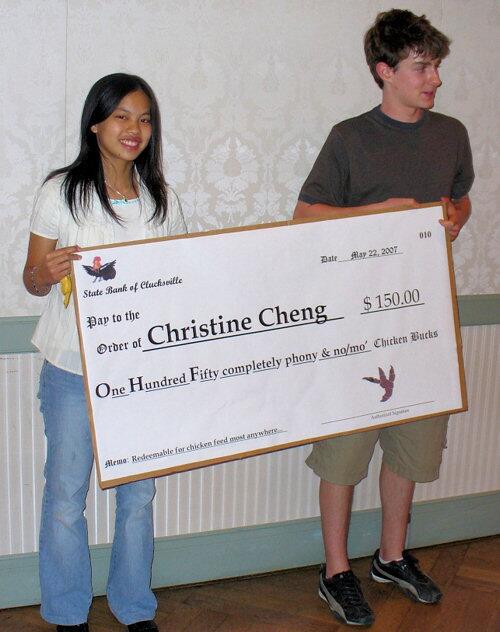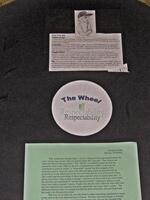
Movie of the award ceremony:
Part 1
2007 Wylde Q. Chicken Award Winner:
Christine Cheng
The Wheel of Respectability
Christine submitted this self-nomination:
I, Christine Cheng, would like to nominate myself on a project called "The Wheel of Respectability" that I completed for my U.S. History class.
My history teacher Bill Sutton assigns monthly "personal reflections" in which he gives students a topic, and they write essays pertaining to that subject. At the beginning of November, he had finished explaining to us a theory called the Wheel of Respectability and its role in explaining the social and political issues of that certain era of American history. We were given the assignment to do a personal reflection on the theory. While procrastinating on writing my essay, I began reading some recent newspaper articles on the French riots that had flared up at the end of October and were still continuing. As I read how the riots and vandalism were bombarding France, I suddenly realized that the issues and events taking place followed the Wheel of Respectability. I researched a bit more on the subject, and an idea took form in my mind: I could create an actual wheel illustrating how the Wheel of Respectability still manifests itself even in the 21st century.
Before I go on, I would like to explain a bit on aforementioned theory, which is a key tool in understanding history. This system (see attached document 1 for a diagram) divided the population back in the 1800s by the level of productivity or skill a certain person contributed to the good of society. A "respectable" person was the exemplar of the productive person. However, there were other deciding factors besides the level of productivity on the Wheel such as the Axis of Limits and the Axis of Power/Privilege. Self-control and the knowledge of limits were essential values to society back then. "Limited upward mobility" demanded that a person must aspire to achieve goals within his/her limits. Those who violated this principal were placed in the "proto- aristocratic" and "rough" wheel sections. The difference between these two groups was that the latter were the powerless and poor whereas the former were the privileged. Also, those who fell between the respectable and rough sections were called "respectable/rough" and those between the respectable and proto-aristocratic were called "respectable/proto-aristocratic."
The result of my deviation from the normal essay homework? A wheel made of two layers of construction paper that allowed others to gain in-depth knowledge about the complex social and political issues surrounding the French riots (see attached documents for pictures of my wheel). I typed up the different groups of people I had found, their positions on the Wheel, and summaries of each group that explained who they were, their actions, and why they were placed at that specific position. All the groups were based on real people involved in the riots. I also drew pictures of each group basing my sketches on what I could glean from the descriptions of the individuals interviewed in the articles. I pasted all my information on one circular layer of construction paper. Then on top of that, I used a fastener to connect another circular shape. I cut out a window on the top layer of the wheel, so people could turn the top layer and see a certain group.
When I brought my Wheel to school that morning, random people stopped by in the hallway just to see what I was holding and to ask, "Did you create that? What’s it for?" When I carried it to class, my colleagues were pretty amazed at the level I had gone for a simple writing assignment. Mr. Sutton, not expecting to receive such a huge "essay," first exclaimed, "Wow, Christine!" and then, "How am I going to bring this home to grade?" We eventually rolled up the wheel and used a rubber band to hold it together, so that he could bring it in his backpack on his bike ride home. (To those who were wondering, I received an A plus and extra credit for my Wheel.)
I believe my project itself gives enough explanation of why I think it meets the criteria of the Wylde Q. Chicken Award. However, to add a bit more to that, Mr. Sutton has also written a recommendation in support for my project (see attached document 3). In addition, I would like to say that I am usually a person who likes to keep exactly to the rules given especially on homework. Why the sudden idea of connecting the French riots to the Wheel of Respectability and then creating a wheel made of construction paper? I do not know. I guess a person sometimes gets tired of doing the same kind of homework again and again. The Wheel may have taken more time out of my schedule than I had planned, but it was well-worth the effort because it gave me a break to use my creative talents and to enjoy doing something as ordinary as homework!
|
To whom it may concern: I am writing in support of Christine Cheng's nomination for the Wylde Q. Chicken award. One of her projects for US History last year consisted of an artboard creation that used the "Wheel of Respectability" theory to illustrate the social and political dynamics of modern-day French riots in context of that theory. It was an outstanding piece of work - academically insightful, artfully presented, and one of the most creative I have ever received in my 12 years of teaching at Uni, and most certainly on a par with the creations of Sara Sligar, who won the award two years ago. It is therefore with great enthusiasm that I nominate Christine Cheng for the coveted Wylde Q. Chicken Award. Sincerely, Bill Sutton |
See Christine's Wheel of Respectability

Honorable Mention:
Julian Hartman
Conic Cooking
Julian submitted this self-nomination:
My name is Julian Hartman. I am a junior. I guess I am nominating myself, though I think Mr. Russell nominated me at some point last year. Last year, I made a video entitled "Conic Cooking" for a math assignment. Conic Cooking was a pretend cooking show, dealing with the conic sections. Complete with conic commercials, this program lasted about half an hour, and included most of the information that I needed to include for the assignment. The assignment was to make a conic notebook, a notebook dedicated to the conic sections, like hyperbolas and all that nasty stuff. It seemed boring. Movies are cool, and you have to admit that chefs cutting up food with big knives are pretty cool too. So I decided to make a conic-cooking show-movie thing. I think that should receive this award, because I make a complete fool of myself in this project, had fun doing it, don't regret it, and like money. And I felt the bit about exporting learning was awesome.
Julian Hartman
Conic Chef Extraordinaire
| Julian submitted this movie for the 2005-06 WQC award, but it fell behind somebody's desk and the judges never saw it until this year. So he resubmitted it for the 2007 award. In watching his 30-minute movie, the judges not only learned many fascinating facts about ellipses and parabolas, but also found themselves giggling repeatedly. And so in the spirit of Better Late than Never, they present a Wylde Q. Chicken Honorable Mention to Julian Hartman. |